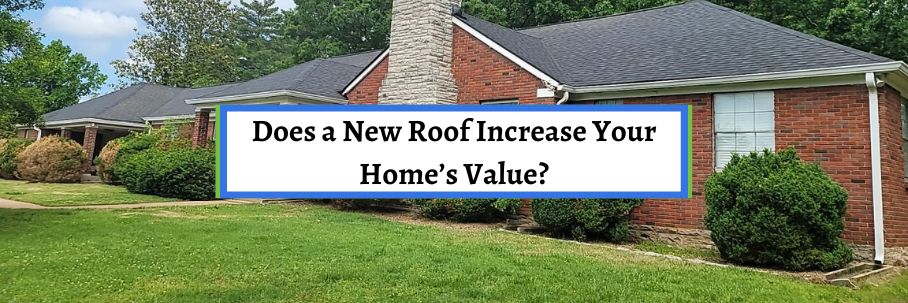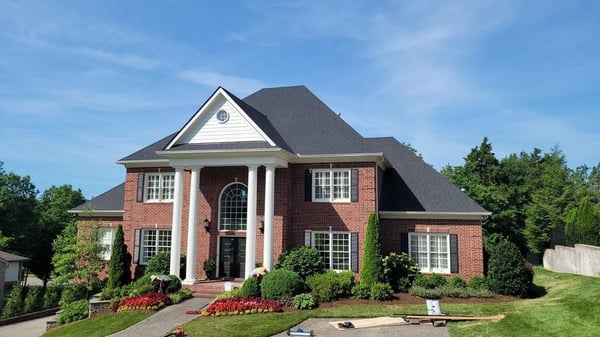Does a New Roof Increase Your Home’s Value?

Anytime you invest money into a home improvement project, you expect a return on investment (ROI) when selling your home. Getting a new roof is no different.
Normally, a roof’s main ROI is its lifespan and the number of years it protects your home. But you obviously don’t get the usual ROI if you’re selling your home now or in the near future.
So, does the ROI show up by adding value to your home’s selling price? Or are you just out of luck?
For over 30 years, the team at Bill Ragan Roofing has helped homeowners understand what a new roof does for them and their home. That’s why I’ll break down what a new roof does for your home’s value.
This article covers the following:
- Does a new roof increase your home’s value?
- How much does a new roof increase your home’s value?
- 3 more ways a new roof benefits your home and wallet
Does a new roof increase your home’s value?
Yes, a new roof is proven to increase your home's value when putting it on the market. How much value depends on the roofing material and the housing market when selling.
On average, homeowners can expect a home’s value to increase by ~60% of the original roof's price. Unfortunately, you will not see a 100% return on your roof investment.
But no matter what, a new roof adds a nice boost to your home’s resale value. The question that remains is, “How much does it actually add?”.
How much does a new roof increase your home’s value?
According to the 2023 COST VS VALUE REPORT, the 2023 national average for an asphalt shingle roof is $29,136. Per the same report, the national average ROI when replacing an asphalt roof is 61.1%.

This means you can expect your home’s value to increase by $17,807 of the original $29,136 you spent to replace your asphalt roof when selling your home. But as I said, each roofing material has its own ROI percentage and how much it increases your home’s resale value.
Let’s use a standing seam metal roof as an example. The 2023 national average cost for a standing seam metal roof is $47,414.

Even though it's more expensive and more durable than an asphalt shingle roof, the national average ROI is 48.9%. In this instance, you can expect a standing seam metal roof to add $23,163 to your home’s resale value.
Just keep in mind that these are national average costs and percentages. So, it’s possible these numbers are different in your area.
3 more ways a new roof benefits your home and wallet
Now you know how much value a new roof adds to your home. However, a new roof offers much more than value when selling your home.
Let’s look at 3 more benefits a new roof provides you and your home.
1. A new roof improves your home’s curb appeal
Curb appeal is the visual attractiveness of your home from the street or the curb. While there are plenty of ways to improve it, a roof has a huge impact on your home’s curb appeal.
 (Left: before; Right: after)
(Left: before; Right: after)
A new roof is proven to increase your home’s overall aesthetic, which factors into adding value when selling your home. Just know that the type of roofing material you choose determines how much your home’s curb appeal.
For example, an architectural asphalt shingle roof is the most common type of roofing material in the country. While it still increases your home’s look, it’s simply not a head-turner.
.png?width=600&height=338&name=BlogPictures%20(2).png) (Left to right: luxury shingles, cedar shakes, synthetic shingles)
(Left to right: luxury shingles, cedar shakes, synthetic shingles)
This is where luxury shingles, synthetic shingles, cedar shakes, and slate tiles come in. These materials are guaranteed to make your home stand out but are extremely expensive.
2. A new roof decreases your home’s energy bills
If you currently have an older roof, its materials aren’t the same quality or as efficient as today’s materials. With the technological advancements in the industry, the components and ventilation systems are more efficient.
This means your AC or heating unit won’t have to work as hard as it did before getting a new roof, which brings your energy bill down. While improved technology plays a key role in decreasing your home’s energy bill, proper attic ventilation is the key.
Other than needing a new HVAC system, improper attic ventilation is the number one cause of a unit having to work harder to stay at the desired temperature. Let’s say the temperature outside is 90°F
An improperly ventilated attic can get as hot as 170˚F, which can cause the trapped heat to get up to as high as 140˚F at floor level. I guarantee any room below this attic won’t be cool enough to sit in until the sun goes down, plus your AC will run harder throughout the day to try to cool it down.
No matter the temperature outside, improper ventilation equals higher energy bills that will continue until the attic is ventilated correctly. Luckily, getting a new roof is the best time to fix ventilation issues.
3. You’ll avoid spending more in the long run on continuous repairs
There’s no way around the fact that a new roof is a significant investment. Unfortunately, the sticker shock leads some people to pay for repairs over and over again.
The upfront cost of a new roof is intimating, but it can actually end up being cheaper than a roof that needs continuous repairs. Repair costs may not be substantial on the surface, but they stack up quickly.
That’s why I recommend just buying a new roof if the repair costs are around 30% of the cost of a full replacement. On top of paying for roof repairs, you also have to consider the damage the frequent leaks are doing to the interior of your home and the costs associated with fixing them.
If you need a new roof, you need a new roof. Repairs on a roof that needs replacing are only band aids you’re throwing money at without fixing the issue.
What do you need to consider before getting a new roof?
After reading this article, you now know the benefits of a new roof. While these benefits aren’t necessarily tangible, they do save you money and keep you from constantly checking the weather.
Now, it’s time to determine what’s next and contact a roofer to start the process of getting a new roof. But before you do, there are some things you need to consider.
With a new roof being the sizable investment that it is, the last thing you want is to get taken advantage of, make the wrong decision, or throw your money away. That’s why I wrote an article on what every homeowner needs to consider before replacing their roof.
Check out 7 Things to Consider Before a Roof Replacement to learn what you should keep in mind when getting a new roof.


